Sensor Sweep: Mech Warrior, Commandos, Jim Shooter, Tomorrow War
Monday , 19, July 2021 Sensor Sweep 1 CommentReview (With Both Hands): Dark Operator, the first book in the five book series by John “Doc” Spears, Jason Anspach, and Nick Cole [Amazon link] is the most thrilling example of careful planning, diligent preparation, and conscientious execution that I have ever read. And yes, I’m totally serious about that.
series by John “Doc” Spears, Jason Anspach, and Nick Cole [Amazon link] is the most thrilling example of careful planning, diligent preparation, and conscientious execution that I have ever read. And yes, I’m totally serious about that.
Games (The Wert Zone): AD 3022. The Inner Sphere of human space is embroiled in the closing stages of the Third Succession War, a series of conflicts between the Great Houses for  power and territory. Largely unaffected by the conflict is the Aurigan Coalition, a minor power among the Periphery States which has flourished under the rule of House Arano. Lady Kamea Arano is about to take her place as the head of the house when her uncle launches a brutal coup. Kamea disappears and one of her guardians, a MechWarrior of impressive skill, is rescued by a band of mercenaries.
power and territory. Largely unaffected by the conflict is the Aurigan Coalition, a minor power among the Periphery States which has flourished under the rule of House Arano. Lady Kamea Arano is about to take her place as the head of the house when her uncle launches a brutal coup. Kamea disappears and one of her guardians, a MechWarrior of impressive skill, is rescued by a band of mercenaries.
Writers (DMR Books): My first encounter with the fiction of Charles R.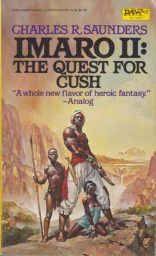 Saunders occurred when I was in junior high. I found a copy of The Year’s Best Fantasy Stories: 3 in a used bookstore. That anthology was a revelation to me at the time and deserves its own blog entry…but I digress. Among the excellent stories within it was Saunders’ “The Pool of the Moon”, a tale of Imaro.*
Saunders occurred when I was in junior high. I found a copy of The Year’s Best Fantasy Stories: 3 in a used bookstore. That anthology was a revelation to me at the time and deserves its own blog entry…but I digress. Among the excellent stories within it was Saunders’ “The Pool of the Moon”, a tale of Imaro.*
 Westerns/Interview (Western Fictioneers): If you’re like me, the authors who make a living writing are a source of inspiration and in some way a role model for what is possible. Over the course of this continuing author interview series, there have been many such authors. James Reasoner is no exception. It is hoped you will enjoy and learn as much as I have in this fun and inspiring interview.
Westerns/Interview (Western Fictioneers): If you’re like me, the authors who make a living writing are a source of inspiration and in some way a role model for what is possible. Over the course of this continuing author interview series, there have been many such authors. James Reasoner is no exception. It is hoped you will enjoy and learn as much as I have in this fun and inspiring interview.
Heroes (Brain Leakage): Of my three favorite stories of all time, two are directly related to a pop culture transition that happened in America in the 1980s, one more obvious in retrospect than it was in real-time. I’m talking about the complete shift from Cowboys to Commandos as our “default” pop cultural heroes.
Review (Marzaat): It sounds like the elements of a typical western except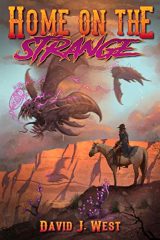 it’s not because this is another in West’s Cowboys & Cthulhu tales. There’s something in the Pulpit besides hostile Indians. And there’s a voice in Hannah’s head who is giving her advice that she and Rockwell will need to drive the enemy in the mountain off.
it’s not because this is another in West’s Cowboys & Cthulhu tales. There’s something in the Pulpit besides hostile Indians. And there’s a voice in Hannah’s head who is giving her advice that she and Rockwell will need to drive the enemy in the mountain off.
Comic Books (Bleeding Fool): Comics legend Jim Shooter is probably most notable for his successful (and controversial) run as Marvel Comics’ ninth editor-in-chief, as well as his work as editor in chief of Valiant Comics. Jim Shooter, the editor-in-chief of Marvel Comics between 1978 and 1987, is a key figure in the history of American comics publishing. He may also be the most disparaged. One of the reasons he was considered “controversial” by some is that he did not accept hackery and laziness.
RPG (Grognardia): In my weekly summaries of the contents of Chaosium’s Different Worlds magazine issues, I rarely comment on the letters column, “Different Views.” Occasionally, though, there are entries worthy of commentary and, in such cases, I make a post to highlight them. In issue #22 (July 1982) – about which I’ll talk tomorrow – there’s a lengthy letter written by Lawrence Schick, a game designer once employed by TSR, perhaps best known for White Plume Mountain. Schick was also editor of Deities & Demigods, an AD&D book about which I have generally negative feelings and it’s about that book that he penned the letter that appeared in Different Worlds.
Science Fiction (Australian Chesterton Society): When the science fiction author Gene Wolfe died in 2019, the obituaries made frequent mention of G.K. Chesterton and his influence on the best-selling author. Wolfe, an engineer prior to becoming a popular writer of science fiction, singled out Chesterton’s writings as among the greatest inspirations in his life. (As a former engineer, he revealed that another major influence was Marks’ Standard Handbook for Engineers!)
Big Thoughts (Rawle Nyanzi): A 2016 article from The New Yorker details the Simulation Hypothesis, or the idea that we are living in a highly elaborate computer program rather than a base reality. According to the article, quite a few people within the scientific community buy into the idea, citing the fast pace of technological change in our current world.
History (Real Crusades History): In much popular literature, the Sultan Salah ad-Din, more commonly known as Saladin, is portrayed not only as chivalrous but also invincible. Even his critical biographer, Andrew Ehrenkreutz, attributes Saladin’s failure to defeat the forces of Christianity sooner than 1187 to Saladin’s obsession with crushing his Muslim rivals rather than to any capability on the part of his Christian foes. While it is undoubtedly true that Saladin spent more time and resources defeating his Muslim rivals, the theory glosses over the fact that Saladin led three full scale invasions of the Kingdom of Jerusalem before his successful campaign of 1187 — and he was defeated each time.
Cinema (Arkhaven Comics): Time travel movies are always a problem. Either they fall into logical pitfalls due to screwing around in the past or they are in the predestination genre, where everything the character does advances a narrative that you already learned in the first half of the movie. The latter can be clever, but the truth is after you’ve seen a couple you’ve seen them all. Which makes that its own form of predestination. I’ll get into the problems this film has in a little bit.
Either they fall into logical pitfalls due to screwing around in the past or they are in the predestination genre, where everything the character does advances a narrative that you already learned in the first half of the movie. The latter can be clever, but the truth is after you’ve seen a couple you’ve seen them all. Which makes that its own form of predestination. I’ll get into the problems this film has in a little bit.
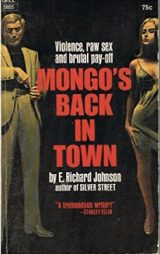 Paperbacks (Paperback Warrior): It’s Christmastime as Mongo Nash arrives home to an unnamed city on a Greyhound bus. However, this is no ordinary trip home after a six-year absence. You see, Mongo is a killer-for- hire, and he’s back to take care of a contract killing at the request of his brother, Mike. The brothers have a complicated relationship involving a bar and a girl that Mike arguably stole from Mongo. But when Mike needs someone whacked, he still calls his hitman brother to get the job done.
Paperbacks (Paperback Warrior): It’s Christmastime as Mongo Nash arrives home to an unnamed city on a Greyhound bus. However, this is no ordinary trip home after a six-year absence. You see, Mongo is a killer-for- hire, and he’s back to take care of a contract killing at the request of his brother, Mike. The brothers have a complicated relationship involving a bar and a girl that Mike arguably stole from Mongo. But when Mike needs someone whacked, he still calls his hitman brother to get the job done.
T.V./Paperback (Glorious Trash): Mike Jahn, who wrote the earlier Six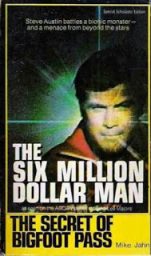 Million Dollar Man tie-in Wine, Women And War, returns with another tie-in paperback, this one novelizing the famous Bigfoot episodes of the series. Actually I should make that the first Bigfoot episodes, as the creature returned in a later two parter. Anyway at 154 pages of big print, The Secret Of Bigfoot Pass comes off more like a novella, and Jahn does not go for the same sort of crafted approach as he did with that earlier tie-in. This one reads like what it is: a quick novelization of a goofy story.
Million Dollar Man tie-in Wine, Women And War, returns with another tie-in paperback, this one novelizing the famous Bigfoot episodes of the series. Actually I should make that the first Bigfoot episodes, as the creature returned in a later two parter. Anyway at 154 pages of big print, The Secret Of Bigfoot Pass comes off more like a novella, and Jahn does not go for the same sort of crafted approach as he did with that earlier tie-in. This one reads like what it is: a quick novelization of a goofy story.
Culture (Art of Manliness): Before Steve McQueen’s 18th birthday, he had worked on a farm, joined a circus, sold pens at a traveling carnival, hitchhiked and rode the rails across the country, worked as a lumberjack in Canada, labored on a chain gang in the Deep South (punishment for the crime of vagrancy), served a short (and illegal — he was underage) stint in the Merchant Marine, and joined the Marine Corps for a three-year enlistment.
Fiction (Bloody Spicy Books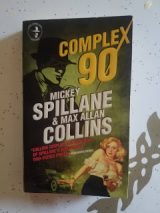 ): There a far too few writers like Mickey Spillane around, in fact there was only ever one writer (not author) like Mickey. He was a true American original who enthralled countless readers since his days writing them funny books (i.e. comics) but with the creation of Mike Hammer, Mickey found himself a winner and when I found both Mickey and Mike I found a life-long companion.
): There a far too few writers like Mickey Spillane around, in fact there was only ever one writer (not author) like Mickey. He was a true American original who enthralled countless readers since his days writing them funny books (i.e. comics) but with the creation of Mike Hammer, Mickey found himself a winner and when I found both Mickey and Mike I found a life-long companion.
Fiction/Cinema (Future War Stories): uring the Cold War, there was a  concern held by NATO, the US Intelligence agencies, and the general public that the big bad Soviet Union was ahead technologically when compared to the western powers. This collective fear was likely rooted in the 1957 launch of Sputnik. In 1977, Welsh author Craig Thomas published the techno-thriller novel Firefox playing on those fears and when only a few years, a major motion picture that was under the helm of none other than Clint Eastwood. For many of us growing up in the 1980’s, this was a cool film about a cool airplane with a cool actor.
concern held by NATO, the US Intelligence agencies, and the general public that the big bad Soviet Union was ahead technologically when compared to the western powers. This collective fear was likely rooted in the 1957 launch of Sputnik. In 1977, Welsh author Craig Thomas published the techno-thriller novel Firefox playing on those fears and when only a few years, a major motion picture that was under the helm of none other than Clint Eastwood. For many of us growing up in the 1980’s, this was a cool film about a cool airplane with a cool actor.
Review (Porpor Books): Following his death in 1993, the ‘Bolo’ supertank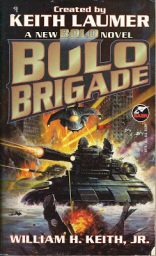 franchise of Keith Laumer continued under the aegis of Baen Books, who issued reprints of Laumer’s stories and novels along with new entries in the franchise. William H. Keith Jr. (b. 1950) is an American author with extensive short story and novel credits for a number of licensed properties, including ‘Cybernarc’ (as by ‘Robert Cain’), ‘Battletech’, ‘Doctor Who’, and ‘Buck Rogers’. During the 2010s Keith, Jr. has been active in writing entries for the ‘Star Carrier’ line of eBooks for the Harper Voyager imprint of Harper Collins.
franchise of Keith Laumer continued under the aegis of Baen Books, who issued reprints of Laumer’s stories and novels along with new entries in the franchise. William H. Keith Jr. (b. 1950) is an American author with extensive short story and novel credits for a number of licensed properties, including ‘Cybernarc’ (as by ‘Robert Cain’), ‘Battletech’, ‘Doctor Who’, and ‘Buck Rogers’. During the 2010s Keith, Jr. has been active in writing entries for the ‘Star Carrier’ line of eBooks for the Harper Voyager imprint of Harper Collins.
History (Claremont Review of Books): As recently as 2014, biographer Michael Korda was able to describe Lee in Clouds of Glory as “universally admired even by those who have little or no sympathy toward the cause for which he fought.” Korda might have been thinking of Dwight Eisenhower, who considered Lee one of the four greatest Americans and hung his portrait in the Oval Office alongside those of the other three (Benjamin Franklin, George Washington, and Lincoln). “General Robert E. Lee was, in my estimation, one of the supremely gifted men produced by our Nation,” Eisenhower wrote, “selfless almost to a fault and unfailing in his faith in God. Taken altogether, he was noble as a leader and as a man, and unsullied as I read the pages of our history.”
Art (Pulpfest): Not long after the pulp industry began emerging and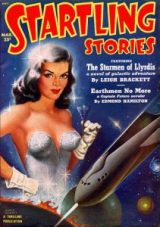 expanding in such magazines as THE ARGOSY, THE POPULAR MAGAZINE, THE ALL-STORY MAGAZINE, and THE MONTHLY STORY MAGAZINE, a “seedier” kind of pulp was born. Rather than “Big, Clean Stories of Outdoor Life” and other varieties of wholesomeness, SNAPPY STORIES, THE PARISIENNE, and BREEZY STORIES offered sex and scandal. Featuring “Live Wire Fiction” and “Chic, Amusing, Illustrated Fiction,” these pulps were the forebearers of the girlie magazines and the spicies.
expanding in such magazines as THE ARGOSY, THE POPULAR MAGAZINE, THE ALL-STORY MAGAZINE, and THE MONTHLY STORY MAGAZINE, a “seedier” kind of pulp was born. Rather than “Big, Clean Stories of Outdoor Life” and other varieties of wholesomeness, SNAPPY STORIES, THE PARISIENNE, and BREEZY STORIES offered sex and scandal. Featuring “Live Wire Fiction” and “Chic, Amusing, Illustrated Fiction,” these pulps were the forebearers of the girlie magazines and the spicies.
 Pulp Science Fiction (Fantasy Literature): Feeling in need lately of some good old-fashioned pulp thrills, Williamson style, I chose at random one of his earliest novels, The Stone From the Green Star, and wow, am I ever glad I did! This novel originally appeared as a two-part serial in the October and November 1931 issues of Hugo Gernsback’s Amazing Stories magazine, the very first publication to dedicate itself solely to science fiction.
Pulp Science Fiction (Fantasy Literature): Feeling in need lately of some good old-fashioned pulp thrills, Williamson style, I chose at random one of his earliest novels, The Stone From the Green Star, and wow, am I ever glad I did! This novel originally appeared as a two-part serial in the October and November 1931 issues of Hugo Gernsback’s Amazing Stories magazine, the very first publication to dedicate itself solely to science fiction.
Horror (Old Style Tales): Every summer there are nights that I feel the urge to wander into the shady woods of my native Midwest: the air has a soft, steamy texture that carries the heavy odors of rain-soaked earth, sun-warmed grass, and air-stirred flowers, the days are lengthy and bright, the nights short and warm, and the outdoors ring with the harmonics of frogs and cicadas hidden in the dark. I haven’t been camping in a few years, but I still get that restless feeling to pack up the car and drive to some remote state park where the trees block the sky and the land rolls in a twisting surf of craggy hills and misty vales.
Pulp (Dark Worlds Quarterly): “Spotted Satan” was a jungle horror-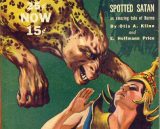 adventure that appeared in one of the final Farnsworth Wright issues of Weird Tales (January 1940). The authors were two familiar names on the contents page, Otis Adelbert Kline and E. Hoffman Price. How the two men divided the work is hard to tell but Hoffman brought his expert knowledge of foreign places, requiring the editor to use a lot of asterisks and footnotes of explanation. Kline can be seen more in the novella’s conclusion, which I will discuss in full later.
adventure that appeared in one of the final Farnsworth Wright issues of Weird Tales (January 1940). The authors were two familiar names on the contents page, Otis Adelbert Kline and E. Hoffman Price. How the two men divided the work is hard to tell but Hoffman brought his expert knowledge of foreign places, requiring the editor to use a lot of asterisks and footnotes of explanation. Kline can be seen more in the novella’s conclusion, which I will discuss in full later.
D&D (Jeffro’s Space Gaming Blog): Note that real D&D gameplay is fundamentally at odds with the assumptions of most modules. Dwimmermount– which until last year had produced the best set of game sessions I had ever experienced– is conceived of as a set of rooms that the players can wander into at any time and then experience a gradually unfolding sense of a weird D&D campaign world. Yes, interesting things should emerge as the players explore, but the setup assumes a more static dungeon environment than I think the rules imply.
Cinema (Goodman Games): And if his story ended there, it would certainly be enough—but of course, it doesn’t. The visuals and dynamics created by Harryhausen weighed heavily on the minds of others, which evidence indicates included the imaginations of Gary Gygax and the other people responsible for the creation of Dungeons and Dragons. Ray Harryhausen is credited as being the special effects wizard on sixteen films, and all of them are worth note. Hints and touches from each of them work their way into various aspects of fantasy role-playing, but there are four films in particular that I want to talk about today.
be enough—but of course, it doesn’t. The visuals and dynamics created by Harryhausen weighed heavily on the minds of others, which evidence indicates included the imaginations of Gary Gygax and the other people responsible for the creation of Dungeons and Dragons. Ray Harryhausen is credited as being the special effects wizard on sixteen films, and all of them are worth note. Hints and touches from each of them work their way into various aspects of fantasy role-playing, but there are four films in particular that I want to talk about today.
Cinema (Beware the Blog): There is a myth called, “Hollywood”, and the “Universal Film Manufacturing Company” was part of it. A myth I describe in my article, “HOLLYWOOD: Segregated Housing, Motion Picture Studios and Movie Palaces”, at: http://www.bewaretheblog.com/2019/04/hollywood-segregated-housing-motion.html.
Robert E. Howard (DMR Books): In my mind, Mr. Howard’s stories carry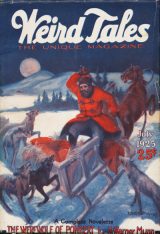 with them a taste of both the Gothic and the Decadent movement; it is rather an unorthodox approach towards Decadence, verily noted, but there it is nonetheless, and that taste, that kind of mood, can be found in many of his writings. Understanding this dark mood will help Howard fans translate and relish his stories in a far more potent manner. His stories apparently reject the decadent and come equipped with a fury and action-oriented energy that keeps it in line with Sword and sorcery, but his works hold up certain questions and concerns that the Decadent movement has, and his stories show shades of the weird and the Dark Romantic too.
with them a taste of both the Gothic and the Decadent movement; it is rather an unorthodox approach towards Decadence, verily noted, but there it is nonetheless, and that taste, that kind of mood, can be found in many of his writings. Understanding this dark mood will help Howard fans translate and relish his stories in a far more potent manner. His stories apparently reject the decadent and come equipped with a fury and action-oriented energy that keeps it in line with Sword and sorcery, but his works hold up certain questions and concerns that the Decadent movement has, and his stories show shades of the weird and the Dark Romantic too.
Fiction (Track of Words): Edited by Charlotte Llewelyn-Wells, The Devourer 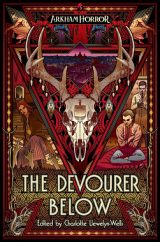 Below is part of Aconyte Books’ growing range of Arkham Horror fiction and features eight short stories from seven different authors all exploring a sinister presence rising in Arkham. Dangerous deals are being made, threats issued, lives devastated and plots hatched, monsters emerging and reluctant heroes standing up, all in the name of or in defiance of a darkness that few truly understand. From local landmarks to the dark countryside that borders the city, detectives and grieving widows to bootleggers and vagrant children, these stories explore Arkham and its inhabitants in dark, unsettling detail, united by a common theme – sometimes overt, other times implied – of a monstrous, corrupting power and the sinister servants it can call upon.
Below is part of Aconyte Books’ growing range of Arkham Horror fiction and features eight short stories from seven different authors all exploring a sinister presence rising in Arkham. Dangerous deals are being made, threats issued, lives devastated and plots hatched, monsters emerging and reluctant heroes standing up, all in the name of or in defiance of a darkness that few truly understand. From local landmarks to the dark countryside that borders the city, detectives and grieving widows to bootleggers and vagrant children, these stories explore Arkham and its inhabitants in dark, unsettling detail, united by a common theme – sometimes overt, other times implied – of a monstrous, corrupting power and the sinister servants it can call upon.
RPG (Grognardia): The news that Chaosium is reprinting many of its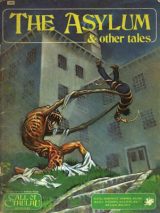 earliest Call of Cthulhu products in celebration of the game’s 40th anniversary this year, I found myself thinking back wistfully on my early experiences with the game. Even though Shadows of Yog-Sothoth looms very large in my memories, I also think fondly of other products from around the same time, like 1983’s The Asylum & Other Tales. Whereas Shadows of Yog-Sothoth was a collection of seven adventures forming “a global campaign to save mankind.
earliest Call of Cthulhu products in celebration of the game’s 40th anniversary this year, I found myself thinking back wistfully on my early experiences with the game. Even though Shadows of Yog-Sothoth looms very large in my memories, I also think fondly of other products from around the same time, like 1983’s The Asylum & Other Tales. Whereas Shadows of Yog-Sothoth was a collection of seven adventures forming “a global campaign to save mankind.
Great Jim Reasoner interview! The man is a legend.
Another excellent post from Dan Davis.
Good stuff from Real Crusades History. The ‘invincible’ “Saint Saladin” was neither.
Mongo Nash, SMDM/Bigfoot, McQueen, Spillane, FIREFOX, BOLO tanks and Robert E. Lee: Boss levels of ‘T’ achieved.